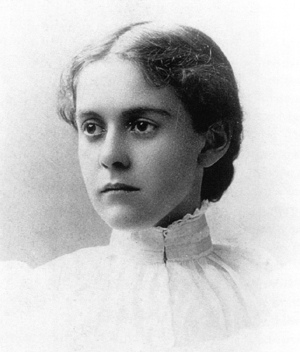Like the work of Dr. Frances Kelsey on Thalidomide, which led to the Kefauver-Harris amendment strengthening drug-safety testing, and that of Dr. C. Everett Koop, resulting in the Baby Doe Amendment safeguarding the rights of disabled children, Dr. Hamilton’s work birthed legislation that made the workplace safer, yet another example of science and law marching together to enhance public health.
 But Dr. Hamilton had more prejudices to overcome, along with lots more ignorance to battle. She pioneered the concept that workplaces can be dangerous - an alien idea in America – and developed a methodology to prove it. And then she had to overcome the disregard for the health of immigrants, those most affected by “the dangerous trades,” along with the anti-feminist attitudes of the day – a decade before women received the right to vote.
But Dr. Hamilton had more prejudices to overcome, along with lots more ignorance to battle. She pioneered the concept that workplaces can be dangerous - an alien idea in America – and developed a methodology to prove it. And then she had to overcome the disregard for the health of immigrants, those most affected by “the dangerous trades,” along with the anti-feminist attitudes of the day – a decade before women received the right to vote.
Like many a true leader, Alice Hamilton’s motivation was “to make a difference” – to be of help to others; deciding to become a doctor in her teens, thirty years after Elizabeth Blackwell became the first American woman physician. An acolyte of Jane Addams, Hamilton became a long-standing resident of Hull House, introducing a well-baby clinic, teaching impoverished new mothers to better care for their young, fighting cocaine traffic, and championing birth control.
“I chose medicine not because I was scientifically-minded, for I was deeply ignorant of science. I chose it because as a doctor I could go anywhere I pleased — to far-off lands or to city slums — and be quite sure I could be of use anywhere.”
Graduating from the University of Michigan Medical School in 1892, when there were some 4500 women physicians in America, the school’s focus on science-based medicine stood her in good stead. Gravitating first to bacteriology and then pathology, she became interested in occupational diseases through her experiences at Hull House mingling with laborers and their spouses and seeing their suffering, finding her true métier in 1908 when appointed by the Governor of Illinois to study industrial illness and mortality.
The twenty members of the Commission (doctors, medical students, and social workers) focused on diseases from white phosphorus (found in matches and causing the debilitating phossy jaw), rubber, and explosives, among others. Dr. Hamilton, who focused on lead poisoning (plumbism), led the group. Their 1911 report led to the first Occupational Disease Law providing compensation for Industrial diseases.
“[It was] a good law till the lawyers got at it and messed it up so that a new one had to be framed in 1938.”
– Alice Hamilton, Exploring the Dangerous Trades.
As the Illinois report was finalized, her work came to the attention of Charles Neill, the Commissioner of Labor, who asked her to do nationally what she had done in Illinois. By 1915, she was America’s foremost authority on lead poisoning. She overturned the belief that hazardous exposure to lead was via ingestion (i.e., that the workers didn’t wash their hands or scrub their nails), focusing on the dangers of inhaling lead dust.
A “shoe leather epidemiologist.”
As ACSH’s resident toxicologist, Susan Goldhaber, writes, establishing a causal relationship between a toxin and a disease requires a connection between the dose resulting from exposure and the likelihood and severity of illness. At that time, there was no common consensus of where lead exposures occurred, and most early reports seriously underestimated the levels to which the ill were exposed.
Pioneering the practice of tracking down the sources of exposure in the real world ( a practice called shoe-leather epidemiology), Hamilton had to learn all the possible sources of lead use and the extent of dust each industrial process generated, including paint and enameling metalware and bathtubs, and later as a component of diesel fuel.
“Thus I was put on the trail of new lead trades, some of which I had never given thought of- for instance, making freight car seals, coffin “trim,” and decalcomania papers for pottery wrapping, cigars in so-called tin-foil, which is really lead.”
- Alice Hamilton
Attention to science
In addition to identifying dosages, Hamilton had to craft a reliable definition of what constitutes lead poisoning or its case definition. Severe colic and palsy (wrist drop) were the most common features but not the only ones. Hamilton noted that some doctors refused to diagnose lead poisoning unless one of those was present, which, she says, is akin to “refusing to recognize alcoholism unless there was an attack of delirium tremens.”
Yet, as sympathetic as she was to the plight of the lead worker, science led her way. She adopted a strict standard for diagnosis: the presence of “a clear lead line (a bluish line along the gums caused by a deposit of lead sulfide) along with a typical case history, “….Her results were thus deliberately understated.”
After her 1912 report, Lead poisoning in Potteries, Tile Works and the Porcelain Enameled Sanitary Ware, was published, she was attacked by a member of the Ohio State Board of Health (employed by a tile manufacturer using lead) as “this woman [presents] a striking example of exaggeration, either a false and apparently a malicious and slanderous report, or an erroneous one.” [1]
Cumulative Effects
Building on her research and growing recognition by academia and government (at all levels, including international) and using effective communication techniques integrating science and graphic narrative, she paved the way for the science of occupational medicine and today’s governing laws.
Her success involved multiple complex areas of expertise:
- Medical researcher- mastering mechanisms of disease causation and historical knowledge,
- Clinician- developing reliable, objective “case definitions” with biological plausibility,
- Industrial hygienist- investigating the processes of suspect industries and routes of exposure,
- Epidemiologist-identifying populations and risk and sources of exposure, and correlating dose with response,
- Public Health Professional – providing recommendations to ameliorate the conditions, and
- Public Health Communicator- reaching out to the lay audience in speeches and articles in the lay/popular press.
But her soft skills were also abundant:
- Singlemindedness and focus
- Femininity with outspoken boldness, capitalizing on an innate networking ability
- Good, judgment
- Flexibility and resilience and an ability to change beliefs in the face of new data
- Impartial and balanced reporting, using transcendent and empathetic
narratives mixed with scientific accuracy
She personified a medical pioneer, researcher, doctor, teacher, social reformer, suffragist, neo-feminist, and author. Among her resonant achievements was the authorship of the 1925 classic ”Industrial Poisons in the United States,” (and its sequel, Industrial Toxicology (1934, 1949); urging the Surgeon General to institute Commissions on Tetraethyl lead (1925) and Radon (1928), frequent social commentary to the lay audience and contributing to the 1924 Health Committee of the League of Nations on epidemic outbreak dissemination and broadcasting among member unions, and a willingness and ability to engage with the lay audience. and per President Nixon, paving the way for the Occupational Health and Safety Act. [2]
Indeed, perhaps quite relevant to issues we face today was her disdain for the legal community. Here is her advice to colleagues about testifying as an expert.
“Never let the lawyers on the other side bully you or get you confused, which is what they all try to do. Never let yourself forget for a moment how contemptable a part you think they are playing; that will give you the right manner. Your strong point is your entire disinterestedness; the jury cannot help but be impressed by this.” [3]
This rhetoric grew out of her experience testifying against druggists who sold cocaine to schoolboys and her aversion to the then law:
“… [the] law did not make the druggist responsible for his clerk’s actions…[it] provided for a fine but no jail sentence, and the druggist paid the fine easily. Now here was a situation for the legal profession to consider and correct, since the law was manifestly imperfect.” - Alice Hamilton [4]
They say the more things change, the more they stay the same. That’s surely true of exposures to toxins. What’s different? We’re missing today’s, Alice Hamilton.
[1] Barbara Sicherman, Alice Hamilton, A Life in Letters
[2] Vicki McCoy, Alice Hamilton, The Making of a Feminist-Pragmatist Rhetor, Georgia State University
[3] By disinterested, she meant an ability to separate oneself from the work at hand, to accomplish the work for its intrinsic value rather than for self-gratification
[4] Alice Hamilton, What about the Lawyers? Harper’s Magazine October 1931




